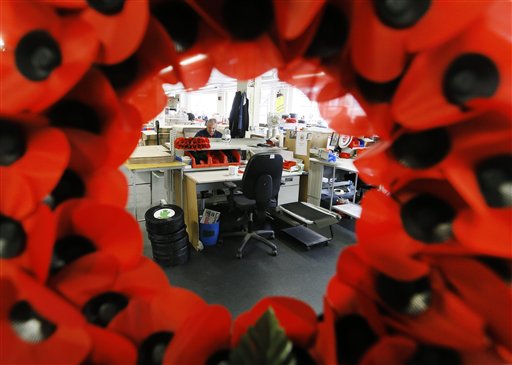LONDON (AP) — William Sellick pinched the tiny scarlet petals with deft ease, turning them into paper poppies and pressing them into a wreath.
The flowers are a potent symbol of remembrance and patriotism that sprang up in the aftermath of World War I to honor the war dead and raise funds for survivors. A century since the Great War, the poppies live on: They are hung as wreaths or worn on lapels across Britain — from Prime Minister David Cameron to X-Factor celebrities to countless commuters braving the blustery streets of London — as the nation prepares to mark Armistice Day on Nov. 11.
Each handmade flower evokes the image of poppies springing up from destruction and decay in Belgium’s Flanders Fields, home to many of the Great War’s bloodiest battlefields. The haunting scene was immortalized in a war poem by Canadian army doctor John McCrae: “In Flanders fields the poppies blow/Between the crosses row on row.”
McCrae noticed that the resilient red corn poppy was the first plant to flourish in the churned-up landscape. The poem, penned in 1915 shortly after McCrae buried a friend, struck a chord around the world and started poppy symbolism in the English-speaking world.
For Sellick, who suffered combat stress after an army tour to Northern Ireland in the 1970s, making poppies is a way to move on from a life shadowed by depression and alcoholism. He doesn’t like to recall his army days, but every November he makes an effort to help plant crosses decorated with poppies outside London’s Westminster Abbey.
“Most of the time when we go out to plant the poppy field it’s wet and windy,” he said with a laugh. “But I always make sure I do the plot for my regiment.”
In this centenary year of World War I, the poppy is more ubiquitous than ever. At the Tower of London, a crimson sea of ceramic poppies floods the ancient moat in a stunning display titled “Blood Swept Lands and Sea of Red.” A total of 888,426 ceramic flowers — each representing a British soldier who died during the war — were planted over the summer, with the last one to be placed on Armistice Day.
Although the poppy is most commonly worn today in Britain and Commonwealth countries like Canada, Australia, and New Zealand, it was a woman from the U.S. state of Georgia who was responsible for turning it into a symbol of the Great War. Moina Michael, a teacher, was so moved by McCrae’s poem that she vowed always to wear a poppy as a way to “keep the faith with all who died.”
Michael started to give poppies to ex-servicemen in New York, where she worked, and the American Legion adopted her idea of selling handmade poppies to raise money for wounded ex-servicemen in 1918. A Frenchwoman soon brought the practice to Britain, where the Royal British Legion began the tradition of a “Poppy Appeal” to help those returning from the war.
The British Army major credited with opening the first factory employing wounded vets as poppy makers had his doubts early on.
“I do not think it can be a great success but it is worth trying,” George Howson wrote in a letter to his parents in 1922.
To this day, the factory in west London’s Richmond makes the bulk of the 45 million poppies, wreaths and crosses sold across Britain. Full-time workers like Sellick assemble each by hand year round, though most of the poppies don’t appear until late October, when they adorn war memorials up and down the country and are sold on virtually every street corner.
Many of the wreaths are featured on Remembrance Sunday, the second Sunday in November, when Queen Elizabeth II leads an annual tribute at London’s Cenotaph to all those who died in World War I and later conflicts.
As time passes, veterans’ groups face the challenge to keep the poppy — and the memories it stands for — relevant and meaningful to a new generation.
Ann Butler, a teacher, was among the many parents who brought their children to see the poppies at the Tower of London.
“They know some of my relatives were in the war. For them to see this, to know that each flower represents someone who died, makes it all more real,” she said. “As the generations go on, there will inevitably be less of a connection.”
There are also those in Britain who avoid the tradition, saying the poppy has become too politicized and nationalistic, or even a symbol that glorifies war. Margaret MacMillan, a historian at Oxford University, said she once reluctantly pinned a poppy when appearing on television because producers insisted she do so.
“There is tremendous pressure for people to wear them,” she said. “Symbols can be useful but you need much more. There’s more to memory than popping it on once a year and forgetting about it.”

COMMENTS
Please let us know if you're having issues with commenting.